The Samsung 850 EVO 4TB SSD Review
by Billy Tallis on July 11, 2016 10:00 AM ESTRandom Read Performance
The random read test requests 4kB blocks and tests queue depths ranging from 1 to 32. The queue depth is doubled every three minutes, for a total test duration of 18 minutes. The test spans the entire drive, which is filled before the test starts. The primary score we report is an average of performances at queue depths 1, 2 and 4, as client usage typically consists mostly of low queue depth operations.
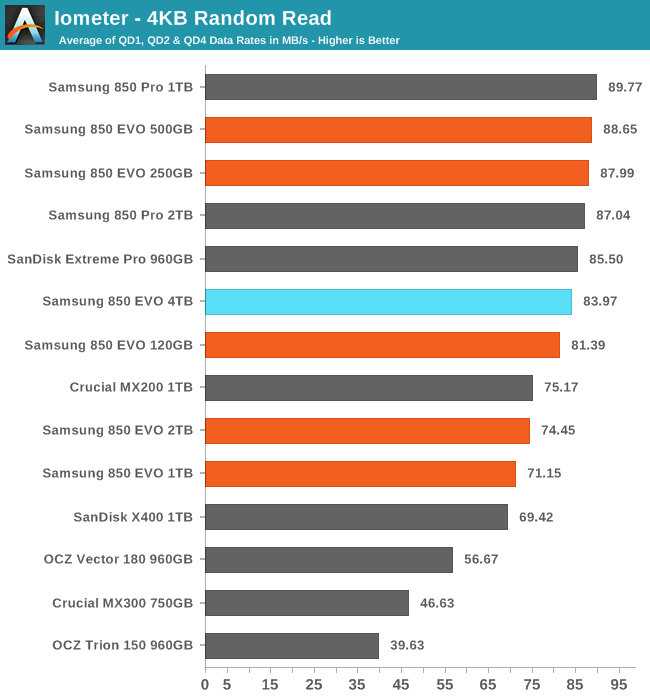
Random read performance of the 4TB 850 EVO is substantially better than the 1TB and 2TB 850 EVOs, but still not quite as fast as the best MLC drives or the 500GB and 250GB 850 EVOs.

The power consumption of the 4TB 850 EVO is slightly higher than the 2TB model, but overall the efficiency is improved over the smaller drive with the same controller but older NAND.
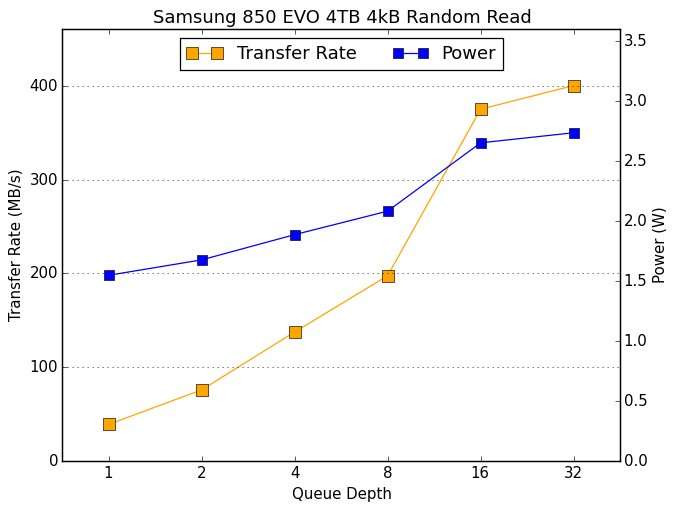 |
|||||||||
The scaling behavior of the 4TB 850 EVO is almost identical to the 2TB model, just with slightly higher performance and power consumption across the board.
Random Write Performance
The random write test writes 4kB blocks and tests queue depths ranging from 1 to 32. The queue depth is doubled every three minutes, for a total test duration of 18 minutes. The test is limited to a 16GB portion of the drive, and the drive is empty save for the 16GB test file. The primary score we report is an average of performances at queue depths 1, 2 and 4, as client usage typically consists mostly of low queue depth operations.
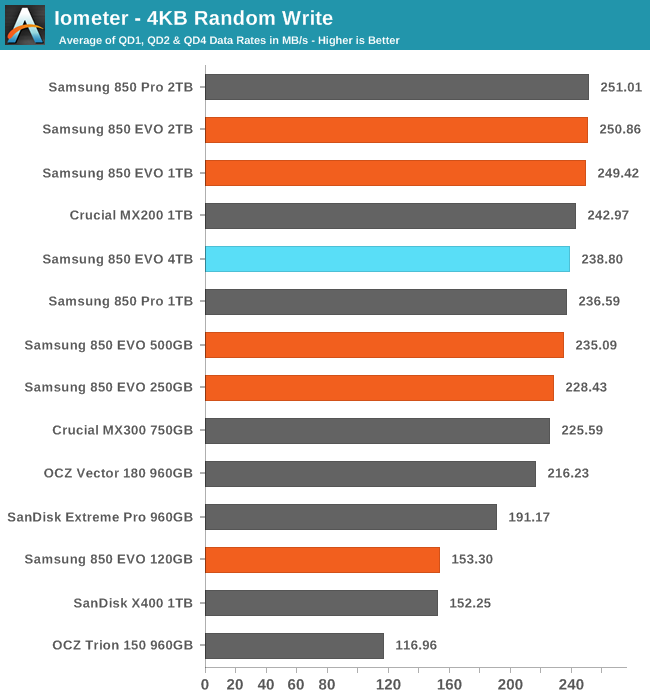
Random write speed for the 4TB 850 EVO is a little bit slower than for the 1TB and 2TB models, but still fast enough to beat almost all non-Samsung drives.
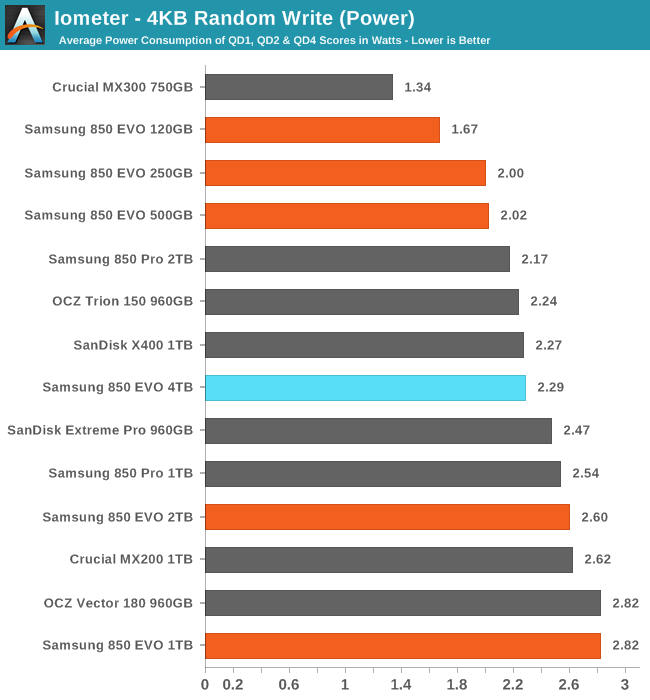
Power consumption of the 4TB 850 EVO is substantially better than the 1TB and 2TB counterparts, making it one of the most efficient large drives. The 750GB Crucial MX300 was still much more efficient.
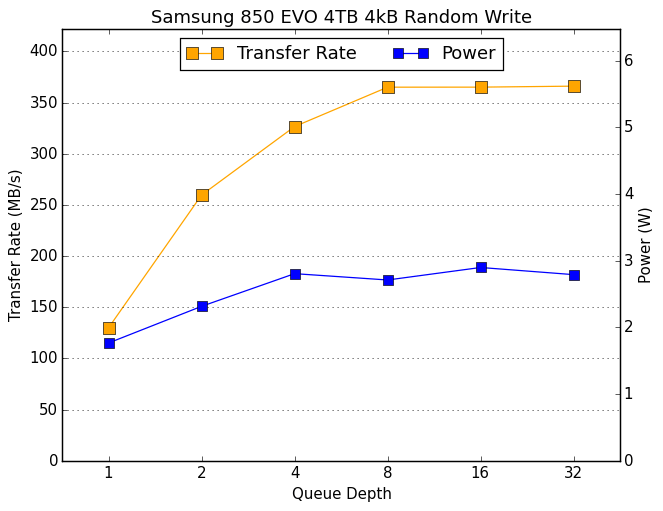 |
|||||||||
The lower performance score for the 4TB was apparently due to a regression in QD4 performance, where the 1TB and 2TB models were able to reach full speed but the 4TB needs a larger queue.










145 Comments
View All Comments
ddriver - Monday, July 11, 2016 - link
That's a valid point, and even though majority of the people who buy consumer stuff are gonna use it on windows, it is still no excuse, it is not like samsung doesn't have the resources to dedicate to proper support.Palorim12 - Tuesday, July 12, 2016 - link
Linux is the only OS affected. Windows and Mac are fine. Disable Queued TRIM and Sequential TRIM will run. So NBD.Kevin G - Monday, July 11, 2016 - link
Samsung has horrible warranty support and they have had a few major issues with their SDDs (840 EVO performance degradation).Samus - Monday, July 11, 2016 - link
Yeah. I had two really sour back to back experiences with Samsung Storage support, one regarding the 840 EVO. After a month of back and fourth communication attempting different firmware updates as support requested, secure erase and reimage, and even trying the drive in another PC as support asked, it was obvious they were in denial of the well documented read performance problem. After RMA they shipped me back another 840 EVO that eventually (after a year) developed the same problems even with the latest firmware update. The problems always come up after a lot of writes like a game install. It wasn't worth the trouble. I would have been happy if they simply replaced the drive with an 850 EVO.Palorim12 - Tuesday, July 12, 2016 - link
The FW update that came out in April completely fixed the issue. I posted several updates on a 840 EVO and an 840 EVO m-sata on Overclock that are fine well over a year since the fix.Palorim12 - Tuesday, July 12, 2016 - link
And they also came out with a fix for the non-EVO 840 recently.Impulses - Wednesday, July 13, 2016 - link
Did they? That's news to me! To teh Google...Impulses - Wednesday, July 13, 2016 - link
Huh, go figure, they DID issue an 840 update towards the end of June (2016)... What the heck took so long? I think most people had rightfully assumed the 840 (non EVO) was abandoned, the EVO did come out like 6 months after it.Apparently the issue was also never quite as severe on the 840 non EVO? Did they ever commit to a fix and it got drowned out over time or did that update happen out of the blue? No AT Pipeline post about it either...
http://www.pcper.com/reviews/Storage/Samsung-Magic...
Palorim12 - Thursday, July 14, 2016 - link
I think its because in most cases, it took longer for the issue to appear in the 840. So it would take longer for them to see if a fix fully worked?SetiroN - Monday, July 11, 2016 - link
Why wouldn't you?When you're talking TBs, that difference translates in HUNDREDS of dollars that I have better use for when Sandisk's performance is already good enough.
This drive only really makes sense in oddly demanding small laptops.